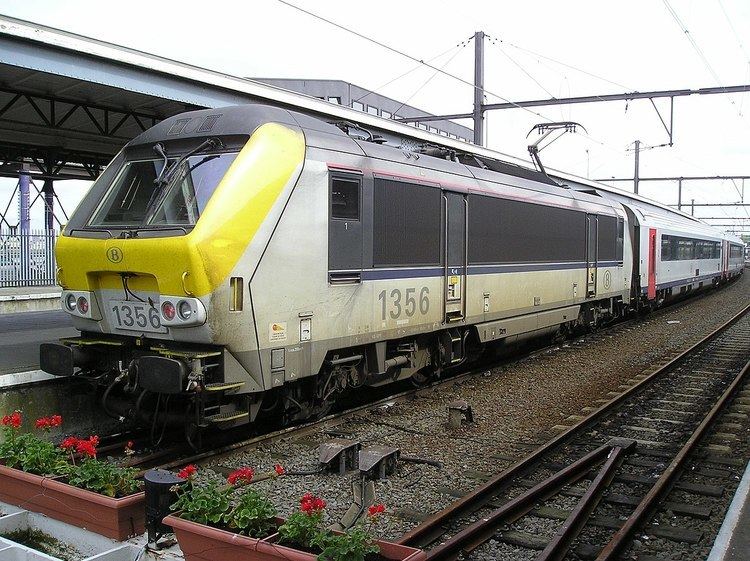Power type Electric Total produced 60 | Build date 1997–2001 UIC class Bo'Bo' | |
 | ||
Builder Alstom (Charleroi/Belfort)
Bombardier Transportation (BN, Bruges) Gauge 1,435 mm (4 ft 8 ⁄2 in) | ||
The SNCB class 13 are a type of mixed use 200 km/h multivoltage electric locomotive of type Tractis designed by Alstom in the late 1990s for the Belgian and Luxembourgish railways (CFL class 3000).
Contents
The locomotives operate push-pull trains with coaches of type I11, as well as freight trains.
Background
At the beginning of the 1990s SNCB had a requirement to renew its mainline locomotive fleet: it required fast high power passenger locomotives for intercity trains on lines between Ostend, Brussels, Liege and Eupen, as well as needing replacements for SNCB diesel locomotive classes 52, 53 and 54 which dated to the 1950s and were used on freight trains for the steel industry on the Maas-Athus line and into Luxembourg. These requirements led to the decision to acquire a universal locomotive design. The design specifications included a minimum top speed of 200 kilometres per hour (120 mph) and capability to operate under 3kV DC and 25kV AC electrification.
Luxembourg state rail company CFL also had a locomotive fleet dating from the 1950/60s, including electric CFL 3600s and GM-EMD diesel engined locomotives CFL 1800. The company also planned to electrify its entire network, the majority at 25kV AC, as well as 3kV DC. In December 1992 CFL reached an agreement to jointly procure locomotives with SNCB, with SNCB leading the procurement process.
The procurement specifications were published in March 1993, accepted bidders were listed in September 1993, with bids received in February 1994. On 22 December 1995 SNCB and CFL made a joint order with ACEC-Transport (subsidiary of GEC-Alstom) for 80 units; Alstom's offer was costed at 140.5million Belgian francs per locomotive; SNCB and CFL ordered 60 (SNCB 13) and 20 (CFL 3000) units respectively of identically specified locomotives, with deliveries beginning in 1998. At the same time as the class 13 order SNCB ordered 21 control cars of type I11 for use with the locomotives on passenger services.
Traction and electrical equipment for the class (including 25kV AC drive, asynchronous motors and GTO inverter technology) was tested on a converted SNCB class 21 locomotive. Pantograph equipment for the class was tested on a SNCB class 27 number 2719.
Design and construction
Input to the design came from ACEC Transport (Charleroi) designing the electrical system and undertaking project coordination, other contributors were: Alstom, Le Creusot, manufacture of the first 30 bogies, the remainder by Stork RMO (Netherlands); Pauwels supplied transformers; Alstom, Onan, traction motors; the first 10 locomotives were manufactured at Alstom, Belfort, the remainder at Bombardier Transportation's factory in Belgium (BN Constructions Ferroviaries et Métalliques, Bruges). Faiveley (pantographs) and Knorr (brake equipment) also supplied components.
The mechanical equipment was identical to the contemporary SNCF BB 36000 Astride: the main frame is constructed of corrosion resistant steel, with 6MJ crash absorbance zones at either end; the locomotive bodywork is of copper plated steel. There are two air conditioned driving cabs, and a central equipment section containing electric and pneumatic equipment, accessed by side corridors. Both primary and secondary suspension are by coil spring with shock absorbers. The transmission system uses a bogie mounted traction motor (one per axle) connected to the wheelset via a hollow shaft drive and flexible coupling, traction forces are tranmissed by low-lying rods connected to the bogie frame. Mechanical braking is by pneumatically operated disc brakes on each axle. The external design takes into account the minimisation of pressure pulses when passing other trains.
The electrical system differs from the SNCF BB 36000 Astride locomotives: current collection is via one of two pantographs, one used for AC electrification supply, the other for DC supply. Under 25kV AC the supply voltage is stepped down by a transformer with four 1375 kW 1520V secondary windings for traction; the traction supply is actively rectified using a pulse chopper circuit. Under 3kV DC electrification the supply voltage is regulated by a chopper to 2200V, producing the same intermiediate DC supply voltage as when under 25kV AC electrification. The intermediate DC link powers four individual three phase GTO-based, heat pipe cooled inverters (one per traction motor); the traction motors are force cooled four pole, three phase asynchronous machines (4FXA4-559B) rated at 1280 kW. The electrical system allows regenerative braking, except under 1.5kV DC electrification, under which the locomotives operate at reduced power.
An additional transformer winding supplies 600-800 kW at 1520V for head end power (heating), there are also 150 kW, 380V, 50 Hz and 15 kW, 110V DC auxiliary supplies.
The locomotives were designed to work in multiple, and in push-pull mode. Safety systems relevant to the countries of operation were fitted.
Introduction and operations
Initial introduction (1998-9) revealed a number of problems relating to electromagnetic interference with signalling and track circuits on introduction of the trains. High levels of electromagnetic noise due to resonance when operating near SNCF BB 15000 or DB Class 181 locomotives in Luxembourg initially caused restriction to single unit working. In Belgium the locomotives were unable to be operated on DC supply due to high levels of 50 Hz harmonics. In France high noise current levels were observed.
By June 2000 the locomotive were able to operate in push-pull mode with I11 coaches, beginning operation on the InterCity G (Ostend-Antwerp) service, and by June 2001 were also operating InterCity A services, sleeper services (TAA) between Brussels and Luxembourg, as well as freight trains between Liege and Luxembourg.
SNCB's order was completed by October 2001.
In December 2002 locomotives of the class began to operate commercial services at their top speed of 200 km/h on InterCity A trains Leuven and Liege.
The SNCB M6 double decker coaches are also used with the SNCB 13 class; in some cases the trains use two control cars, with a class 13 locomotive in the middle, a train formation nicknamed dromadaire (camel).
